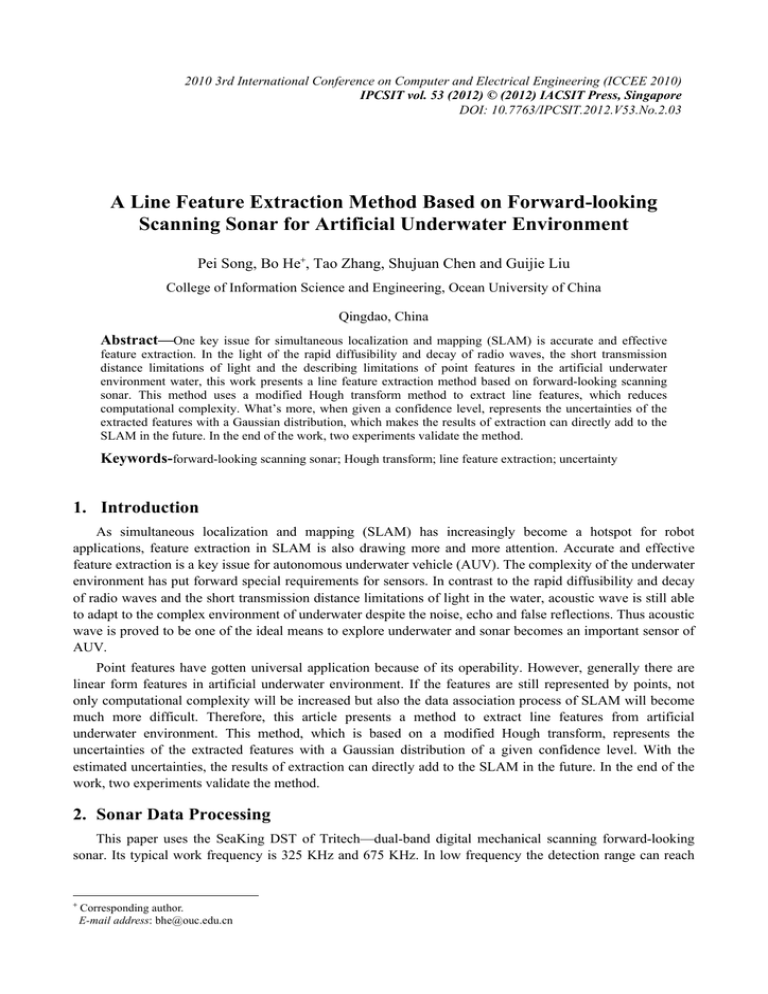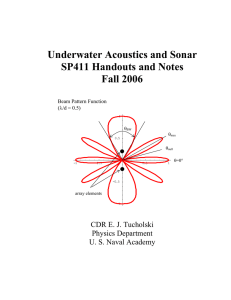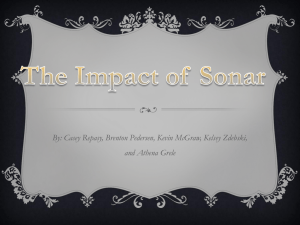Document 13136789
advertisement

2010 3rd International Conference on Computer and Electrical Engineering (ICCEE 2010) IPCSIT vol. 53 (2012) © (2012) IACSIT Press, Singapore DOI: 10.7763/IPCSIT.2012.V53.No.2.03 A Line Feature Extraction Method Based on Forward-looking Scanning Sonar for Artificial Underwater Environment Pei Song, Bo He+, Tao Zhang, Shujuan Chen and Guijie Liu College of Information Science and Engineering, Ocean University of China Qingdao, China Abstract—One key issue for simultaneous localization and mapping (SLAM) is accurate and effective feature extraction. In the light of the rapid diffusibility and decay of radio waves, the short transmission distance limitations of light and the describing limitations of point features in the artificial underwater environment water, this work presents a line feature extraction method based on forward-looking scanning sonar. This method uses a modified Hough transform method to extract line features, which reduces computational complexity. What’s more, when given a confidence level, represents the uncertainties of the extracted features with a Gaussian distribution, which makes the results of extraction can directly add to the SLAM in the future. In the end of the work, two experiments validate the method. Keywords-forward-looking scanning sonar; Hough transform; line feature extraction; uncertainty 1. Introduction As simultaneous localization and mapping (SLAM) has increasingly become a hotspot for robot applications, feature extraction in SLAM is also drawing more and more attention. Accurate and effective feature extraction is a key issue for autonomous underwater vehicle (AUV). The complexity of the underwater environment has put forward special requirements for sensors. In contrast to the rapid diffusibility and decay of radio waves and the short transmission distance limitations of light in the water, acoustic wave is still able to adapt to the complex environment of underwater despite the noise, echo and false reflections. Thus acoustic wave is proved to be one of the ideal means to explore underwater and sonar becomes an important sensor of AUV. Point features have gotten universal application because of its operability. However, generally there are linear form features in artificial underwater environment. If the features are still represented by points, not only computational complexity will be increased but also the data association process of SLAM will become much more difficult. Therefore, this article presents a method to extract line features from artificial underwater environment. This method, which is based on a modified Hough transform, represents the uncertainties of the extracted features with a Gaussian distribution of a given confidence level. With the estimated uncertainties, the results of extraction can directly add to the SLAM in the future. In the end of the work, two experiments validate the method. 2. Sonar Data Processing This paper uses the SeaKing DST of Tritech—dual-band digital mechanical scanning forward-looking sonar. Its typical work frequency is 325 KHz and 675 KHz. In low frequency the detection range can reach + Corresponding author. E-mail address: bhe@ouc.edu.cn 300 meters, while in high frequency due to the narrow beam, the range can’t be longer than 100 meters. So high frequency is usually used in short range detection. SeaKing DST forward-looking scanning sonar head revolves in a manner of "stepping" and launches a beam of acoustic wave to the detection area with a certain vertical and horizontal angle. The sampling points that distribute uniformly in each beam are called bins. After having received the echo, sonar head revolves the same angle until from one side of sonar scanning range to the other, and then returns to repeat these actions [1]. Depending on different settings, when the kinematic velocity of robot is very fast while the rev of sonar is too slow, sonar data can become distorted. This article uses the GPS (Global Position System) data, as well as AHRS (Attitude Heading Reference System) data to correct the sonar data, which will reduce the motion distortion. 2.1. Sonar beam pre-processing This procedure consists of three steps; these three steps are executed beam to beam as they are gotten from sonar. The first step is threshold segmentation [2], during which a threshold of the intensity value is set to filter out noise and the possible false reflections preliminarily. These selected bins, which have a higher intensity values than the threshold, are stored and will be used in the process of uncertainty estimation. The second step is to find the maxima. Take the bin of max intensity value as a reference; discard those bins that do not satisfy the "maximum intensity difference" principle. That’s to say, if the difference between the intensity value of bins after threshold segmentation and the maximum intensity value is too large, those bins will be discarded. This is based on high intensity values are most likely to correspond to objects in current environment. The last step of beam pre-processing is sparseness; discard those bins that do not meet the "minimum distance" principle. In other words, if two previously selected bins are too close to each other, they should correspond to the same object, thus are superfluous and the one with lower intensity value will be discarded. 2.2. Sonar data accessing During once scanning process, the maximum sector that single line can cover is 180°, so we generally use beams of last 180° sector as a unit for storage and subsequent processing, i.e. if the stepping is 0.9°, one unit contains 200 beams. Every new beam arrives, deletes the oldest beam and one unit still contains 200 beams. The information that needs to be stored contains as follows: First, the range and bearing (polar coordinate in sonar reference system) of bins selected after threshold segmentation, which is the first step of beam preprocessing. This information will be used in uncertainty estimation process of line feature extraction. Second, the information of bins got finally in beam preprocessing, which will be used in voting process of line feature extraction. Finally, the robot’s pose estimation at the moment beam arrives. This information is used to correct movement distortion. This paper uses the GPS data and AHRS data as robot pose estimation. GPS provides the robot’s location information, while AHRS provides its angle information. If this method will be used in SLAM in the future, robot’s pose estimation can be provided by SLAM which runs parallel to this algorithm. 2.3. Line feature extraction The method that this article uses to extract line features is based on the improvements of classic Hough transform [3] [4]. Line feature is represented by two parameters, ρ and θ. These two parameters represent respectively the range and angle information with regard to the R reference coordinate system. The basic idea of Hough transform is that utilize the allelism of point and line to make the point in X-Y Cartesian coordinate system and the line in θ-ρ polar coordinate system one to one correspondence. It’s proved that when mapping the points of the same line in Cartesian coordinate to polar coordinate by Hough transform, the result line intersect in one point. In turn, mapping the intersection of polar coordinate to Cartesian coordinate using Hough transform, we can get the initial straight line. In practice, for computational convenience we usually use (1), mapped the point to the curve. ρ = x ∗ cos(θ ) + y ∗ sin(θ ) (1) In this way, the line feature extraction process becomes a process to find the intersection in θ-ρ space, we call this process voting [2] [5] [6]. Line feature extraction process can be divided into the following steps: First, with each new beam of sonar data arrives, set the location of the current sensor as the new reference system R and reference all the stored bins to R, so that they can vote in space. And then distribute the votes of each bin to the candidate line through sonar model. Finally perform a search for the winners to get the extracted line features. 2.4. Voting space Voting space, a two-dimensional space, is used to place the candidate line. By separate this θ-ρ parameter space into two-dimensional grids with a certain resolution, the area of each grid will get a candidate line. Select the sensor location of the moment the last beam reach as a new reference frame R. With each time R reference frame changes, the voting space will be recalculated. This increases the computational complexity, but can avoid the resolution loss and space increases that caused by setting the reference in a fixed position, meanwhile it makes the results of extraction can directly add to the SLAM in the future. The resolution of the voting space depends on sonar perspective and linear resolution settings (ours is 0.9°, 1/6 m). 2.5. Voting Since each beam of sonar has a horizontal angle α (our sensor, 3°) and a vertical angle, a measurement cannot simply be assigned to a single point in the space. Usually the measurement is considered as an arc, as is shown in Fig.1. Fig.1. Sonar model. The size of arc angle depends on α with a resolution of h. Thus a bin is corresponded to h points: α α θSR − ≤ θhR ≤ θSR + 2 2 (2) In addition, not only the line tangent to the arc can produce a high-intensity return, within a certain angle β the intersected surfaces can also produce a discernable return. The truer the obtained sonar data are, the smaller the angle β (experience value should be no less than 25°) should be. The resolution is p, then each bin corresponds to h*p points, i.e. h* p lines [2] [7]: θ hR − β ≤ θ hR, p ≤ θ hR + β Bin’s parameters are ⎡⎣ xSR ySR θSR ρS θhR, p ρhR, p ⎤⎦ transformation from sonar S to reference R. (3) , the first three of which are robot pose coordinate ρ S is the range from bin to the sensor. lines parameters of each bin, which are available from (2) and (3). ρ R h, p is given by (4): ⎡⎣ θ hR, p ρ hR, p ⎤⎦ is h*p ρhR, p = ySR sin(θhR, p ) + xSR cos(θhR, p ) + ρS cos(θhR, p −θSR ) (4) Thus, the h*p votes that each bin corresponds to are assigned to the space grids, with one grid can only receive one vote from any bin, thus the grid obtained the largest number of votes indicating that it is compatible with the biggest number of bins. In consider of multiple lines in one scan, set a minimum number of votes, the grids with more than that number are winners. When finishing the voting process, the winning lines are sent to the uncertainty estimation procedure; meanwhile bins that vote for the winners will be deleted to avoid interfering with next voting. Additional benefits to do this are the reduced computational complexity and avoiding frequently detecting the same line in adjacent voting process. 2.6. Estimate uncertainties To integrate the extracted line feature into the map, correct uncertainty estimation becomes very essential. So we should consider all the selected bins after threshold segmentation. It’s proved that describing the uncertainty of the line as a Gaussian distribution with a given confidence is very suitable [8]. The process is as follows: first, once the voting process detects a line, uncertainty estimate process will assign a confidence level to the segmentation data (this article, 0.95). Then, calculate overlap ratio of the winning line and segmentation data. As the winning line has received a large number of votes, we have enough evidence to accept it as one neighbor of the real line. There are many methods to obtain the overlap ratio, one of which is to calculate the ratio of the actual number of points on the line to the ideal number of points on the line. Next, search from the neighborhood of winner for lines with similar overlap ratio. This set of lines then is converted into a set of points in ρ-θ polar space. Finally the area that the point set occupies is approximated to an ellipse. The center of the ellipse is the mean value. By knowing the major and minor axis of the ellipse, orientation, confidence level, the covariance matrix can be recovered. 3. Experiment Validation 3.1. Experiment in a small pool of C-Ranger laboratory The experiment was carried in a 2m*4m rectangular pool of C-Ranger laboratory for preliminary verification of the algorithm. Because of the regular pool structure and the small noise interference on the sonar, sonar data was ideal. Sonar was placed at (0, 0). The range of sonar was 6m, the stepping was 0.45°, and the scanning scope was 270°. Because the data amount was very small, we used the data of 270° in one circle as the unit to vote in instead of 180°. The results are shown in Fig.2; red solid lines represent the mean of the extracted line features, while the black dotted lines represent their uncertainties. Because the sonar is not placed perpendicular to the wall of the pool, so the image is not perpendicular to the axis. Because the scanning scope is not 360°, bottom left of the pool is not scanned by sonar, so there is no data in this area. Through adjusting the parameters repeatedly, when β took 25°and the minimum number of votes took 15, results were the best. Although data amount of the bottom wall is very small, the extracting method still successfully extracts out the line features. However the data of the four corners is too little to extract the arc. Anyway, the results indicate that the line extracted method is feasible. 3 均均 不不不不 2 1 0 -1 -2 -3 -1.5 -1 -0.5 0 0.5 1 1.5 Fig.2. Small pool experiment result. 3.2. C-Ranger experiment in tuandao bay The experiment was carried in Tuandao Bay on the platform of C-Ranger—a self-developed AUV by our laboratory. Fig.3 shows the experimental AUV platform—C-Ranger. Its onboard sensors include a GPS (Global Position System), a DVL (Doppler Velocity Log), an AHRS (Attitude Heading Reference System), a gyroscope and forward-looking scanning sonar. Fig.3. AUV platform. —C-Ranger Fig.4 shows the sonar that we use in the experiment. The range of sonar in this experiment was 100m, the stepping was 0.9° and the scanning scope was 180°. Fig.5 shows the Google map of this experiment, in which the red line is the GPS trajectory of C-Ranger and the blue points are sonar data. Sonar data is corrected by GPS and AHRS data. To see clearly, soar data are made large sparse. So a great many points are discarded in the picture, but we still can see the profile of the ship and the coast. Fig.4. Sonar of the experiment Fig.5. Google maps and GPS trajectory of C-Ranger Tuandao Bay experiment. Fig.6 shows the eventually extracted line features and their uncertainties, the red solid lines represent the mean of the extracted line features and the black dotted lines represent their uncertainties. As can be seen from the figure, three lines are extracted, of which the lower right in the map is the ship, while the top and the left are the coast line. The extracted features are a bit difference from the actual landmarks, but they coincide with the real in appearance basically. However the arc of the coast isn’t extracted because the points of the arc are too few to vote for a line. 4. Conclusion This article regards Forward-looking Scanning Sonar as the detection system of AUV, introduces a modified line feature extraction method based on Hough transform in artificial environment and meanwhile estimates the uncertainties of the feature. Experimental results show that this method is feasible, but there is still insufficient in extracting arc corners and the real time capability. The algorithm will be further optimized to achieve curve extraction and real-time requirements in the future. Fig.6. Extracted line features and uncertainties. 5. Acknowledgment This research has been funded in part by National 863 Project (No.2006AA09Z231, No.2009AA12Z330), Science and Technology Public Relation Project of Shandong Province (No.2008GG1055011), and DR Fund of Shandong Province (BS2009HZ006). 6. References [1] Jie Zhang, Bo He, Ke Yao, Yitong Wang, Simultaneous Localization and Mapping for an Autonomous Underwater Vehicle Using Forward-looking Sonar, Micro-computer information, 2009, pp. 255–257. [2] Ribas, D., Ridao, P., Tardos, J., and Neira, J., “Underwater slam for structured environments using an imaging sonar,” Ph.D. dissertation, Departament of Computer Engineering, Universitat de Girona, May 2008. [3] Choi, J., Ahn, S., & Chung, W. K. (2005). Robust sonar feature detection for the SLAM of mobile robot. In Proc. of IEEE/RSJ international conference on intelligent robots and systems, pp. 3415–3420. [4] Ballard, D. H.: 1987, Generalizing the Hough transform to detect arbitrary shapes, Morgan Kaufmann Publishers Inc., San Francisco, CA, USA. [5] R. Duda and P. Hart, .Use of the Hough transformation to detect lines and curves in pictures,. Communications of the ACM, 1972. [6] Ribas, D., Ridao, P., Neira, J., Tardos, J.: Slam using an imaging sonar for partially structured underwater environments. In: Proc. of the IEEE International Conference on Intelligent Robots and Systems(IROS 2006), IEEE, Los Alamitos (2006). [7] A. Grossmann, R. Poli, Robust mobile robot localisation from sparse and noisy proximity readings, in: Proceedings of the Workshop on Reasoning with Uncertainty in Robot Navigation, 1999. [8] Ribas, D., Ridao, P., Tardós, J., & Neira, J. (2008). Underwater SLAM in man-made structured environments. Journal of Field Robotics, 25(11–12), pp. 898–921.




